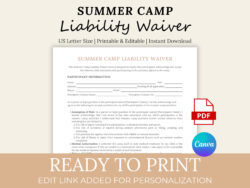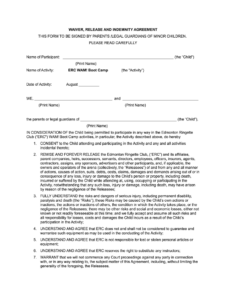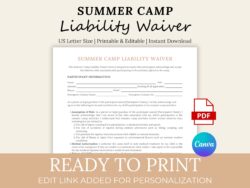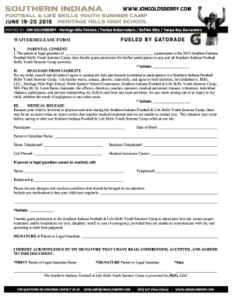Utilizing such a document offers significant advantages for both camps and families. For camp operators, it establishes a layer of legal protection by clearly defining the scope of assumed risks. For parents and guardians, it provides transparency regarding potential hazards and allows them to make informed decisions about their child’s participation. This clarity helps build trust and fosters a more positive relationship between the camp and the families it serves.
The following sections will explore the essential components of these documents, provide guidance on customization for specific camp activities, and offer best practices for implementation and record-keeping. This information aims to equip camp administrators with the knowledge necessary to create and manage effective risk management strategies.

Key Components of a Day Camp Waiver
Effective waiver documents contain specific elements crucial for clarity and enforceability. These components ensure that parents or guardians understand the potential risks and limitations of liability associated with their child’s camp participation.
1. Participant Information: Clear identification of the camper, including full name, date of birth, and contact information, is essential for accurate record-keeping.
2. Parent/Guardian Information: The document must identify the responsible adult granting consent, including their full name, relationship to the camper, and contact details.
3. Activity Description: A comprehensive description of the camp’s activities, including specific sports, excursions, and other potential hazards, should be included.
4. Risk Acknowledgment: A clear statement outlining the inherent risks associated with the described activities is necessary. This section should address potential injuries, illnesses, and other foreseeable hazards.
5. Liability Release: This section specifies the extent to which the camp is released from liability for incidents arising from participation in the described activities. Clear language regarding the scope of the release is crucial.
6. Medical Information and Consent: Provisions for disclosure of relevant medical information about the camper, including allergies, medications, and pre-existing conditions, are essential. Consent for emergency medical treatment should also be included.
7. Photographic Release (Optional): An optional section allowing the camp to use photographs or videos of the camper for promotional purposes can be included.
8. Signature and Date: The document must include spaces for the parent/guardian’s signature and the date of signing, signifying their informed consent and agreement to the terms outlined within the waiver.
Careful consideration of these components ensures comprehensive risk management and fosters a transparent relationship between the camp and participating families. A well-drafted document protects both parties by clarifying expectations and responsibilities related to participation in camp activities.
How to Create a Day Camp Waiver Form Template
Developing a robust waiver form requires careful planning and attention to detail. A well-crafted document provides clarity and protection for both the camp and participating families. The following steps outline a structured approach to creating a comprehensive day camp waiver form template.
1: Consult Legal Counsel: Seeking legal advice is paramount before drafting any legal document. An attorney specializing in liability and waivers can ensure compliance with local regulations and best practices. This consultation helps mitigate potential legal risks and ensures the enforceability of the waiver.
2: Define Scope and Activities: Clearly define the scope of the camp’s activities. List specific sports, excursions, and any potentially hazardous activity. The more comprehensive the description, the more effectively the waiver addresses potential risks.
3: Outline Inherent Risks: Detail the inherent risks associated with each activity listed. Clearly explain potential injuries, illnesses, or other foreseeable hazards participants might encounter. Transparency regarding potential risks is crucial.
4: Craft Clear Liability Release Language: Use precise and unambiguous language to define the scope of the liability release. Specify the circumstances under which the camp is released from responsibility for incidents arising from participation. Ambiguity can undermine the effectiveness of the waiver.
5: Incorporate Medical Information Provisions: Include sections for parents or guardians to disclose relevant medical information about the camper. Allergies, medications, pre-existing conditions, and emergency contact details should be captured. Consent for emergency medical treatment must also be included.
6: Consider Optional Clauses: Evaluate the inclusion of optional clauses, such as a photographic release authorizing the use of the camper’s image for promotional purposes. Clearly explain the purpose and scope of such clauses.
7: Design for Clarity and Readability: Structure the document for clarity and ease of understanding. Use clear headings, concise language, and a logical flow. A well-organized document enhances comprehension and ensures informed consent.
8: Regularly Review and Update: Legal requirements and best practices can change. Regularly review and update the waiver template with legal counsel to ensure ongoing compliance and effectiveness.
By following these steps and incorporating the essential components discussed earlier, camps can create a waiver form that effectively manages risk, communicates expectations clearly, and fosters a safe and positive environment for all participants.
Careful development and implementation of comprehensive waiver documents are crucial for risk management in day camp operations. Understanding the essential components, legal considerations, and best practices associated with these documents allows camp administrators to create a safer environment for participants while protecting the organization from potential liability. A well-drafted document fosters transparency, clarifies expectations, and promotes a positive relationship between the camp and the families it serves.
Prioritizing risk management through diligent use of these protective measures ultimately contributes to a more secure and positive camp experience for all involved. Regular review and adaptation of these documents in consultation with legal counsel ensures their continued effectiveness in the face of evolving circumstances and best practices.



